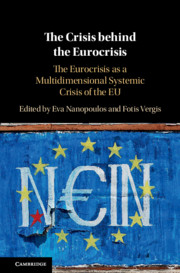Book contents
- The Crisis behind the Eurocrisis
- The Crisis behind the Eurocrisis
- Copyright page
- Dedication
- Contents
- Contributors
- Preface
- Acknowledgements
- Introduction The Elephant in the Room
- 1 There Is No (Legal) Alternative
- Part I The Crisis as a Crisis of the EU’s Identity
- Part II The Crisis as a Crisis of the EU’s Political and Democratic Legitimacy
- 5 Authoritarian Liberalism
- 6 The Inherently Undemocratic EU Democracy
- 7 Europe and Constituent Powers
- 8 ‘Who’s Afraid of the European Demos?’
- 9 Can Public and Voluntary Acts of Consent Confer Legitimacy on the EU?
- Part III The Crisis as a Crisis of the EU’s Economic Model
- Part IV The Crisis as a Crisis of the EU’s Social Character
- Part V Joining the Dots and the Way Forward
- Index
8 - ‘Who’s Afraid of the European Demos?’
The Uneasy Relationship between the European Union and Referendums
from Part II - The Crisis as a Crisis of the EU’s Political and Democratic Legitimacy
Published online by Cambridge University Press: 07 July 2019
- The Crisis behind the Eurocrisis
- The Crisis behind the Eurocrisis
- Copyright page
- Dedication
- Contents
- Contributors
- Preface
- Acknowledgements
- Introduction The Elephant in the Room
- 1 There Is No (Legal) Alternative
- Part I The Crisis as a Crisis of the EU’s Identity
- Part II The Crisis as a Crisis of the EU’s Political and Democratic Legitimacy
- 5 Authoritarian Liberalism
- 6 The Inherently Undemocratic EU Democracy
- 7 Europe and Constituent Powers
- 8 ‘Who’s Afraid of the European Demos?’
- 9 Can Public and Voluntary Acts of Consent Confer Legitimacy on the EU?
- Part III The Crisis as a Crisis of the EU’s Economic Model
- Part IV The Crisis as a Crisis of the EU’s Social Character
- Part V Joining the Dots and the Way Forward
- Index
Summary
In the midst of the multifaceted crisis the European Union (EU) is currently experiencing, almost every recent referendum held on European issues has been regarded as another crack in European unity. Not only have the questions addressed to the people – as well as the respective political campaigns – touched upon key areas of the European crisis such as finance and migration; the answers finally delivered were often also unexpected and sometimes even shocking from a European integration point of view.
The Greek ‘no’ to the bailout referendum in July 2015 and the Danish ‘no’ to an opt-out referendum six months later were followed in 2016 by a Dutch ‘no’ to the Ukraine–EU Association Agreement, by a Hungarian (invalid) ‘no’ to EU refugee-relocation quotas and, of course, by the famous Brexit referendum; the British ‘no’ to the EU itself.
- Type
- Chapter
- Information
- The Crisis behind the EurocrisisThe Eurocrisis as a Multidimensional Systemic Crisis of the EU, pp. 173 - 218Publisher: Cambridge University PressPrint publication year: 2019



